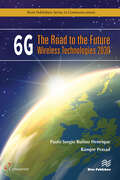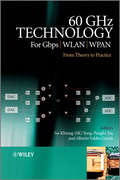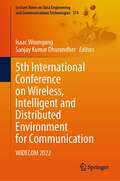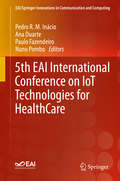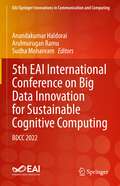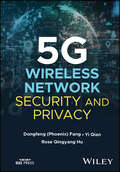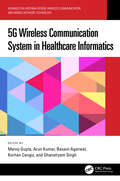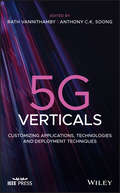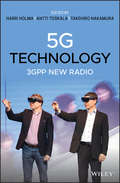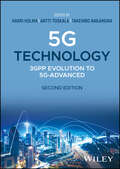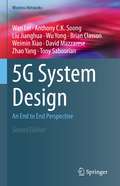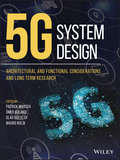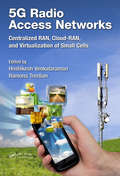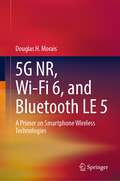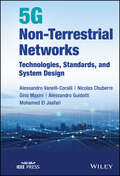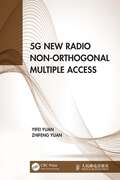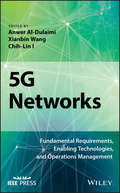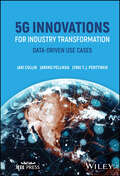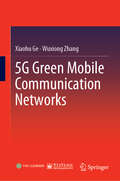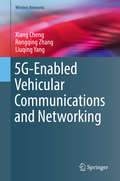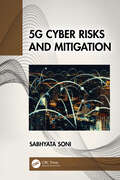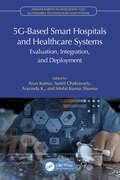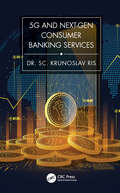- Table View
- List View
6G: The Road To Future Wireless Technologies 2030 (River Publishers Series In Communications Ser.)
by Paulo Sergio Henrique Ramjee PrasadSince the launch of Second-Generation Networks (2G), planning for each future mobile service was initiated many years before its commercial launch. In 2019, 5G Networks begun to be deployed commercially after almost ten years of planning. Similarly, the race for the 6G wireless networks that will be operational in 2030 has already started. To fulfill its potential in the upcoming decade, 6G will undoubtedly require an architectural orchestration based on the amalgamation of existing solutions and innovative technologies. The book will begin by evaluating the state of the art of all current mobile generations' while looking into their core building blocks. 6G implementation will require fundamental support from Artificial Intelligence (AI) and Machine Learning on the network's edge and core, including a new Radio Frequency (RF) spectrum. The 6G use cases will require advanced techniques for enabling the future wireless network to be human-centric, ensuring enhanced quality of experience (QoE) for most of its applications. The concept of Human Bond Communication Beyond 2050 (Knowledge Home) and Communication, Navigation, Sensing, and Services (CONASENSE) will also profit from future wireless communication. Terahertz domains will exploit the ultra-Massive Multiple Input Multiple Output Antennas (UM-MIMO) technologies to support Terabits' data throughputs.Moreover, optical wireless communications (OWC) will also come into play to support indoor and outdoor high-data rates. Further expansion of 6G core entities will support the novel concept of Society 5.0. Quantum computing processing and communications is also likely to be added into the 6G ecosystem with security managed by blockchain orchestration for a robust network.
60GHz Technology for Gbps WLAN and WPAN
by Pengfei Xia Su-Khiong Yong Alberto Valdes-GarciaThis book addresses 60 GHz technology for Gbps WLAN and WPAN from theory to practice, covering key aspects for successful deployment.In this book, the authors focus specifically on 60 GHz wireless technology which has emerged as the most promising candidate for multi-gigabit wireless indoor communication systems. 60 GHz technology offers various advantages over current or existing communications systems (e.g. huge unlicensed bandwidth worldwide, high transmit power, high frequency reuse and small form factor), which enables many disruptive applications that are otherwise difficult if not impossible to be realized at lower frequencies. The book addresses all aspects of the state-of-the-art in 60 GHz technology for high data rate wireless applications.Key Features:Comprehensive coverage from theory to practice: provides readers with a thorough technical guide of 60 GHz technology development Brings together the entire area of 60GHz technology for Gigabits per second (Gbps) WLAN and WPAN applications. Discusses practical system designs covering wide aspects such as antenna propagation, beamforming, circuit design, digital communication, signal processing, system architectures, etc. Provides up-to-date standardization activities, regulatory issues, technology development as well as future trends Includes examples and case studies for practical scenarios Contains theoretical, simulation and experimental results to demonstrate and compare the performance of various schemes (or systems) This book serves as an excellent reference for system engineers, system architects, IC designers, standard engineers, researchers, and vendor and manufacturer consumers. Technical consultants, software and application developers will also find this book of interest.
60 Seconds & You're Hired!
by Robin RyanWhether you're just starting out, moving onwards and upwards, or re-entering the job market, 60 Seconds and You're Hired! provides the quickest route to getting the job and salary you deserve. Filled with insider's tips from managers and human resource personnel and real-life success stories, it presents sure-fire strategies for success in your next interview, including: --The best response to the interviewer's questions --How to communicate that you are the best person for the job --What intelligent, informed questions to ask about the company and position --How to avoid common pitfalls that cause most candidates to fail --Negotiating the best salary and benefits package possible Robin Ryan's proven and easy-to-use techniques are certain to help you find a satisfying place for yourself in today's ever-changing business world.
60 Seconds and You're Hired!, Revised Edition
by Robin RyanNow fully revised and updated-the must-have guide to acing the interview and landing the dream job For the past decade, 60 Seconds & You're Hired! has helped thousands of job seekers get the perfect job by excelling at the crucial job interview. Now, in this new edition, America's top career coach Robin Ryan offers proven strategies to help readers take charge of the interview process and get the job they want. Brief, compact, and packed with useful tips, 60 Seconds & You're Hired! features:* Unique techniques like "The 60 Second Sell" and "The 5-Point Agenda"* More than 100 answers to tough interview questions* Questions you should always ask* 20 interview pitfalls to avoid* Negotiation techniques that secure higher salaries* And much more!From the Trade Paperback edition.
5th International Conference on Wireless, Intelligent and Distributed Environment for Communication: WIDECOM 2022 (Lecture Notes on Data Engineering and Communications Technologies #174)
by Isaac Woungang Sanjay Kumar DhurandherThis book presents the proceedings of the 5th International Conference on Wireless Intelligent and Distributed Environment for Communication (WIDECOM 2022), which took place at the University of Windsor, Windsor, Canada, October 12-14, 2022. The book addresses issues related to new dependability paradigms, design, and performance of dependable network computing and mobile systems, as well as issues related to the security of these systems. The goal of the conference is to provide a forum for researchers, students, scientists and engineers working in academia and industry to share their experiences, new ideas and research results in the above-mentioned areas.
5th EAI International Conference on IoT Technologies for HealthCare (EAI/Springer Innovations in Communication and Computing)
by Nuno Pombo Pedro R. M. Inácio Ana Duarte Paulo FazendeiroThis book presents papers from HealthyIoT 2018, the fifth edition of an international scientific event series dedicated to Internet of Things and Healthcare. The papers discuss leveraging a set of existing and emerging technologies, notions and services that can provide many solutions to delivery of electronic healthcare, patient care, and medical data management. HealthyIoT brings together technology experts, researchers, industry and international authorities contributing towards the design, development and deployment of healthcare solutions based on IoT technologies, standards, and procedures. HealthyIoT 2018 is part of the 4th annual Smart City 360˚Summit, promoting multidisciplinary scientific collaboration to solve complex societal, technological and economic problems of emerging Smart Cities. The event is endorsed by the European Alliance for Innovation, an international professional community-based organisation devoted to the advancement of innovation in the field of ICT.Features practical, tested applications in IoT for healthcare;Includes application domains such as eHealth Systems, smart textiles, smart caring environments, telemedicine, wellness, and health management, etc;Applicable to researchers, academics, students, and professionals.
5th EAI International Conference on Big Data Innovation for Sustainable Cognitive Computing: BDCC 2022 (EAI/Springer Innovations in Communication and Computing)
by Anandakumar Haldorai Arulmurugan Ramu Sudha MohanramThis book features the proceedings of the 5th EAI International Conference on Big Data Innovation for Sustainable Cognitive Computing (BDCC 2022). The papers feature detail on cognitive computing and its self-learning systems that use data mining, pattern recognition and natural language processing (NLP) to mirror the way the human brain works. This international conference focuses on technologies from knowledge representation techniques and natural language processing algorithms to dynamic learning approaches. Topics covered include Data Science for Cognitive Analysis, Real-Time Ubiquitous Data Science, Platform for Privacy Preserving Data Science, and Internet-Based Cognitive Platform.
5G Wireless Network Security and Privacy (IEEE Press)
by DongFeng Fang Yi Qian Rose Qingyang Hu5G WIRELESS NETWORK An expert presentation of 5G security, privacy, and network performance In 5G Wireless Network Security and Privacy, a team of veteran engineers delivers a robust and accessible discussion of 5G security solutions, including physical layer security, authentication, and mobility management. In the book, the authors expertly cover the requirements of 5G wireless network security and privacy, with explorations of existing solutions and vulnerabilities from security architecture and mechanism perspectives. Readers will learn how to enhance the security and network performance of 5G wireless networks in contexts like vehicle‐to‐vehicle and vehicle‐to‐infrastructure communications, industrial automation, health services, smart cities, and smart homes. They will develop a comprehensive understanding of 5G wireless network security as they move through the book’s 11 insightful chapters, developing in‐depth knowledge on the current state of 5G security and coming developments in the field. Readers will also find: A thorough introduction to legacy cellular network security, including network performance development from 1G to 4G In‐depth treatments of 5G network security, including the motivation and objectives of 5G wireless network security Comprehensive explorations of wireless security solutions, including cryptographic approaches and physical layer security Fulsome discussions of the security architecture of cellular networks, including 3G and 4G security Perfect for researchers and professionals working in the field of cybersecurity and 5G wireless networks, 5G Wireless Network Security and Privacy will also earn a place in the libraries of engineers, computer scientists, and graduate students studying 5G network security and privacy.
5G Wireless Communication System in Healthcare Informatics (Advances in Antenna Design, Wireless Communication and Mobile Network Technology)
by Manoj Gupta Arun Kumar Basant Agarwal Korhan Cengiz Ghanshyam SinghThis text discusses problems and needs with the implementation of a 5G mobile communications system in the healthcare sector. It covers the issues related to advanced modulation schemes, telehealth, and remote diagnosis. It discusses important topics including virtual healthcare monitoring, spectrum sensing techniques, the role of 5G in medical applications, the role of nano- communication in healthcare informatics, and remote diagnosis. The text will be useful for graduate students, academic researchers, and professionals in the fields of electrical, and electronics and communication engineering, and allied healthcare. This book: Discusses novel architecture to manage the allocation of resources, and the interference issue among existing and advanced radios Provides focus to estimate the performance, cost and accommodation of the next generation technology design for the IoT, modern health- care, and education Covers advanced technologies and their role in healthcare Discusses key topics including spectrum access, advanced waveforms, which can help in standardization of 5G based smart hospital Explores the impact of telemedicine in smart healthcare This reference text covers the latest advances in the field of 5G mobile communication for healthcare informatics, addressing both original algorithm development and new applications of 5G mobile Communications.
5G Verticals: Customizing Applications, Technologies and Deployment Techniques
by Rath Vannithamby Anthony C.K. SoongA comprehensive text to an understanding the next generation mobile broadband and wireless Internet of Things (IoT) technologies 5G Verticals brings together in one comprehensive volume a group of visionaries and technical experts from academia and industry. The expert authors discuss the applications and technologies that comprise 5G verticals. The earlier network generations (2G to 4G) were designed as on-size-fits-all, general-purpose connectivity platforms with limited differentiation capabilities. 5G networks have the capability to demand customizable mobile networks and create an ecosystem for technical and business innovation involving vertical markets such as automotive, healthcare, manufacturing, energy, food and agriculture, city management, government, public transportation, media and more. 5G will serve a large portfolio of applications with various requirements ranging from high reliability to ultra-low latency going through high bandwidth and mobility. In this book, the authors explore applications and usages of various 5G verticals including a set of key metrics for these uses and their corresponding target requirements. The book also examines the potential network architectures and enabling technologies to meet the requirements of 5G verticals. This important book: Offers a comprehensive resource to the promise of 5G Verticals Provides a set of key metrics for the uses and target requirements Contains illustrative examples of the technology and applications Includes contributions from experts in the field and professionals that developed the 5G standards Provides an analysis of specific vertical industries which have the potential to be among the first industries to use 5G Written for industry practitioners, engineers and researchers, 5G Verticals discusses the technology that enables the 5G system to be flexibly deployed and scaled.
5G Technology: 3GPP New Radio
by Harri HolmaA comprehensive guide to 5G technology, applications and potential for the future 5G brings new technology solutions to the 5G mobile networks including new spectrum options, new antenna structures, new physical layer and protocols designs and new network architectures. 5G Technology: 3GPP New Radio is a comprehensive resource that offers explanations of 5G specifications, performance evaluations, aspects of device design, practical deployment considerations and illustrative examples from field experiences. With contributions from a panel of international experts on the topic, the book presents the main new technology components in 5G and describes the physical layer, radio protocols and network performance. The authors review the deployment aspects such as site density and transport network and explore the 5G performance aspects including data rates and coverage and latency. The book also contains illustrative examples of practical field measurement. In addition, the book includes the most recent developments in 4G LTE evolution and offers an outlook for the future of the evolution of 5G. This important book: Offers an introduction to 5G technology and its applications Contains contributions from international experts on the topic Reviews the main technology components in 5G Includes information on the optimisation of the Internet of things Presents illustrative examples of practical field measurements Written for students and scientists interested in 5G technology, 5G Technology: 3GPP New Radio provides a clear understanding of the underlying 5G technology that promotes the opportunity to take full benefit of new capabilities.
5G Technology: 3GPP Evolution to 5G-Advanced
by Harri Holma Antti Toskala Takehiro Nakamura5G TECHNOLOGY An Essential Insider’s View of the Development Work of 5G Technology Up to Release 18 5G brings new technology solutions to the 5G mobile networks, including new spectrum options, antenna structures, physical layer and protocols designs, and network architectures. 5G Technology: 3GPP Evolution to 5G-Advanced is an accessible and comprehensive resource that offers explanations of 5G specifications and performance evaluations, aspects of device design, practical deployment considerations and illustrative examples from field experiences. With contributions from a panel of international experts on the topic (industry insiders working at the forefront of development), the book presents the main new technology components in 5G and describes the physical layer, radio protocols, and network performance indicators associated with them. It has intentionally been written to cater to individuals at all levels of 5G expertise. Some of the topics of discussion and learning resources in the work include: An easy-to-understand insider’s overview of 5G from editors and authors who are actively working with the 5G development in 3GPP, the forum defining the requirements Deployment aspects, such as site density and transport network, plus exploration into 5G performance aspects, including data rates, coverage, and latency A large number of illustrations including simulation and measurement results of 5G technology performance, plus key 5G procedures Updated information on industrial IoT, radio enhancements in Releases 16 and 17, open RAN and virtualized RAN, 5G verticals and new use cases, and the 5G-Advanced development in Release 18 and outlook towards Release 19 5G Technology: 3GPP Evolution to 5G-Advanced serves as a complete resource for wireless researchers, network planners, lecturers in universities, technology analysts, R&D engineers, application developers, and spectrum regulators who wish to thoroughly understand the latest in 5G technology and get ahead of the curve with regards to its potential applications in a wide variety of industries.
5G System Design: An End to End Perspective (Wireless Networks)
by Wan Lei Liu Jianghua Wu Yong Brian Classon Weimin Xiao David Mazzarese Zhao Yang Tony Saboorian Anthony C.K. SoongThis book presents a detailed pedagogical description of the 5G commercial wireless communication system design, from an end to end perspective, by those that were intimate with its development. The exposition only assumes that the reader is passingly familiar with LTE and builds upon that knowledge. By comparing and contrasting NR with LTE, it allows for quick mastering of 5G. As such it gives concise and highly accessible description of the key technologies in the 5G physical layer, radio access network layer protocols and procedures, how the 5G core and EPC is integrated into the radio access network, how virtualization, slicing and edge computer will fundamentally change the way we interact with the network, as well as 5G spectrum issues.The 2nd edition of this book significantly enhances and updates the first edition by adding 5G security and Release-16 developments. Loosely speaking, 5G Release-15 can be characterized as being optimized for the cellular carrier eMBB service while 5G Release-16 is the beginning of the optimization of 5G for the vertical industries. It mainly focused on the support of the vehicular vertical and Industrial Internet of Things. As such, we have significantly altered the first edition to cover the key features standardized in Release-16 including: URLLC, V2X, IIoT, enhanced MIMO, unlicensed access, positioning, power savings and IAB. On the network side, detailed discussion covers NR security as well as the newly standardized access traffic steering, non 3GPP access switching and splitting features, non 3GPP access network support and private networks.Engineers, computer scientists and professionals from those with a passing knowledge of 4G LTE to experts in the field will find this book to be a valuable asset. They will gain a comprehensive understanding of the end to end 5G commercial wireless system. Advanced-level students and researchers studying and working in communication engineering, who want to gain an understanding of the 5G system (as well as methodologies to evaluate features and technologies intended to supplement 5G) will also find this book to be a valuable resource.
5G System Design: Architectural and Functional Considerations and Long Term Research
by Patrick Marsch Ömer Bulakci Olav Queseth Mauro BoldiThis book provides a comprehensive overview of the latest research and standardization progress towards the 5th generation (5G) of mobile communications technology and beyond. It covers a wide range of topics from 5G use cases and their requirements, to spectrum, 5G end-to-end (E2E) system architecture including core network (CN), transport network (TN) and radio access network (RAN) architecture, network slicing, security and network management. It further dives into the detailed functional design and the evaluation of different 5G concepts, and provides details on planned trials and pre-commercial deployments across the globe. While the book naturally captures the latest agreements in 3rd Generation Partnership Project (3GPP) New Radio (NR) Release 15, it goes significantly beyond this by describing the likely developments towards the final 5G system that will ultimately utilize a wide range of spectrum bands, address all envisioned 5G use cases, and meet or exceed the International Mobile Telecommunications (IMT) requirements for the year 2020 and beyond (IMT-2020). 5G System Design: Architectural and Functional Considerations and Long Term Research is based on the knowledge and consensus from 158 leading researchers and standardization experts from 54 companies or institutes around the globe, representing key mobile network operators, network vendors, academic institutions and regional bodies for 5G. Different from earlier books on 5G, it does not focus on single 5G technology components, but describes the full 5G system design from E2E architecture to detailed functional design, including details on 5G performance, implementation and roll-out.
5G Radio Access Networks: Centralized RAN, Cloud-RAN and Virtualization of Small Cells
by Hrishikesh Venkatarman Ramona TrestianC-RAN and virtualized Small Cell technology poses several major research challenges. These include dynamic resource allocation, self-configuration in the baseband pool, high latency in data transfer between radio unit and baseband unit, the cost of data delivery, high volume of data in the network, software networking aspects, potential energy savings, security concerns, privacy of user’s personal data at a remote place, limitations of virtualized environment, etc. This book provides deeper insights into the next generation RAN architecture and surveys the coexistence of SDN, C-RAN and Small Cells solutions proposed in the literature at different levels.
5G NR, Wi-Fi 6, and Bluetooth LE 5: A Primer on Smartphone Wireless Technologies
by Douglas H MoraisThis book provides, at a high level and in a tractable fashion, a description of how wireless communications are achieved in the latest smartphones. The author shows how smartphones communicate via three separate systems, namely 5G NR, Wi-Fi 6, and Bluetooth Low Energy 5. He explains how 5G NR allows mobile voice and high-speed data communication, how Wi-Fi allows smartphone attachment to the Internet independent of 5G NR, and how Bluetooth allows smartphone attachment to speakers, in-car entertainment systems, smart watches, etc. This text explains the key basic technologies employed and then addresses how each system operates. This book is of interest to anyone with a rudimentary scientific understanding who desires to know more at an intuitive level rather than rigorous one how smartphones achieve wireless communications.
5G Non-Terrestrial Networks: Technologies, Standards, and System Design
by Alessandro Vanelli-Coralli Nicolas Chuberre Gino Masini Alessandro Guidotti Mohamed El Jaafari5G Non-Terrestrial Networks Provides a complete and detailed description of the non-terrestrial component in the 5G ecosystem 5G Non-Terrestrial Networks is the first multi-authored reference dedicated to the integration of non-terrestrial networks (NTN) into the 5G ecosystem. Written by leaders in the development of the 3GPP 5G NTN specification, this authoritative resource addresses all key aspects of non-terrestrial components of 5G systems, including standardization, architecture, protocols, and regulatory considerations. Drawing from their expertise in academic and industrial research and development, the authors introduce fundamental principles of non-terrestrial communications, define the NTN architecture and radio protocol stacks, describe applications to support mobility and radio resource management, and more. The book covers 5G New Radio-based technology for NTN as well as LTE NB-IoT/eMTC, providing a well-rounded understanding of the unique characteristics of 5G-NTN systems. Throughout the text, the authors offer insights on various design approaches, technical choices, and trade-off options. In addition, the book: Addresses the integration of non-terrestrial networks into 5G systems at all levels Describes the principles of non-terrestrial systems, including orbital parameters, link budget, propagation, and space/ground segments Includes a detailed overview of 5G-NTN system architectures, deployment scenarios, and spectrum aspects Covers NB-IoT and eMTC in NTN, NTN use cases, 5G QoS, and New Radio Discusses the potential of non-terrestrial components of 5G in the future 6G ecosystem 5G Non-Terrestrial Networks is a must-have for communication engineers, satellite network operators, aerospace and electrical engineers, network engineers, academic researchers and industry professionals involved in 5G infrastructure development, as well as advanced students taking courses on 5G and satellite communication.
5G New Radio Non-Orthogonal Multiple Access
by Yifei Yuan Zhifeng YuanThis book provides detailed descriptions of downlink non-orthogonal multiple transmissions and uplink non-orthogonal multiple access (NOMA) from the aspects of majorly used 5G new radio scenarios and system performance. For the downlink, the discussion focuses on the candidate schemes in 3GPP standards which are not only applicable to unicast services but also to broadcast/multicast scenarios. For the uplink, the main target scenario is massive machine-type communications where grant-free transmission can reduce signaling overhead, power consumption of devices and access delays. The design principles of several uplink NOMA schemes are discussed in-depth, together with the analysis of their performances and receiver complexities. Devoted to the basic technologies of NOMA and its theoretical principles, data analysis, basic algorithms, evaluation methodology and simulation results, this book will be an essential read for researchers and students of digital communications, wireless communications engineers and those who are interested in mobile communications in general.
5G Networks: Fundamental Requirements, Enabling Technologies, and Operations Management
by Anwer Al-Dulaimi Xianbin Wang Chih-Lin IA reliable and focused treatment of the emergent technology of fifth generation (5G) networks This book provides an understanding of the most recent developments in 5G, from both theoretical and industrial perspectives. It identifies and discusses technical challenges and recent results related to improving capacity and spectral efficiency on the radio interface side, and operations management on the core network side. It covers both existing network technologies and those currently in development in three major areas of 5G: spectrum extension, spatial spectrum utilization, and core network and network topology management. It explores new spectrum opportunities; the capability of radio access technology; and the operation of network infrastructure and heterogeneous QoE provisioning. 5G Networks: Fundamental Requirements, Enabling Technologies, and Operations Management is split into five sections: Physical Layer for 5G Radio Interface Technologies; Radio Access Technology for 5G Networks; 5G Network Interworking and Core Network Advancements; Vertical 5G Applications; and R&D and 5G Standardization. It starts by introducing emerging technologies in 5G software, hardware, and management aspects before moving on to cover waveform design for 5G and beyond; code design for multi-user MIMO; network slicing for 5G networks; machine type communication in the 5G era; provisioning unlicensed LAA interface for smart grid applications; moving toward all-IT 5G end-to-end infrastructure; and more. This valuable resource: Provides a comprehensive reference for all layers of 5G networks Focuses on fundamental issues in an easy language that is understandable by a wide audience Includes both beginner and advanced examples at the end of each section Features sections on major open research challenges 5G Networks: Fundamental Requirements, Enabling Technologies, and Operations Management is an excellent book for graduate students, academic researchers, and industry professionals, involved in 5G technology.
5G Innovations for Industry Transformation: Data-driven Use Cases
by Jari Collin Jarkko Pellikka Jyrki T. Penttinen5G INNOVATIONS FOR INDUSTRY TRANSFORMATION Authoritative resource providing insight on real-life industrial 5G use cases in driving customer value, productivity, and sustainability ambitions With 5G innovations rapidly expanding to different areas within technology, 5G Innovations for Industry Transformation provides key information on how 5G technology can positively impact digital transformation in the industry sectors, discussing new data-driven business opportunities, including green digital transition, new standards for sustainability, and real-time data-driven services, introducing case studies that cover a variety of industries, from the oil & gas industry to the telecom industry, along with the lessons learned from these case studies, and providing insights into how 5G technology will transform businesses by sharing real-time customer solutions, fair data sharing principles, and ecosystem and change management. The book summarizes novelty aspects in a compact and practical way to benefit users and specialists in the field who want to understand some of the very key aspects of 5G. To aid in reader comprehension, the book contains tables, figures of technical principles and architectural block diagrams, and photographs further explaining key topics. Sample topics covered in 5G Innovations for Industry Transformation include: 5G SA technology with new capabilities, 5G private networks, and how smart, connected products are transforming competition Implications of 5G applied to your particular business and/or industry, and how to scale up and industrialize based on these implications How to lead the charge in relation to optimizing business practices based on the advent of 5G, and details on navigating the platform economy How 5G affects data privacy and security, and other integrated capabilities of 5G, such as processes, data, technology, and competencies Based on real-world experiences and high-quality research and presenting practical examples that serve as a useful guiding hand, 5G Innovations for Industry Transformation is an essential resource for change leaders, enterprise architects, and software developers of any industrial enterprise seeking to drive digitalization forward in their value chain and organization.
5G Green Mobile Communication Networks
by Xiaohu Ge Wuxiong ZhangThis book focuses on the modeling, optimization, and applications of 5G green mobile communication networks, aimed at improving energy efficiency and spectrum utilization in 5G systems. It offers a balance between theoretical analysis and engineering practice, providing in-depth studies of a number of major topics, such as energy consumption models, optimization, system design, implementation, and performance evaluation. It also discusses four aspects of green communication in detail: cellular networks, resource management, wireless transmissions and multi-media communications. Further, this unique book comprehensively and systematically discusses green optimization in wireless mobile communications. As such it is a valuable resource for researchers, engineers, and graduate students in various fields, including telecommunications engineering, electrical and electronic engineering, and computer engineering, particularly those interested in green communications.
5G-Enabled Vehicular Communications and Networking (Wireless Networks)
by Xiang Cheng Rongqing Zhang Liuqing YangThis book investigates and reviews recent advanced techniques and important applications in vehicular communications and networking (VCN) from a novel perspective of the combination and integration of VCN and connected vehicles, which provides a significant scientific and technical support for future 5G-based VCN.5G-Enabled Vehicular Communications and Networking introduces vehicular channel characteristics, reviews current channel modeling approaches, and then provides a new generic geometry-based stochastic modeling approach for vehicle-to-everything (V2X) communications. The investigation of vehicular channel measurements and modeling provides fundamental supports for the VCN system design. Then, this book investigates VCN-vehicle combination from PHY and MAC layers, respectively. As for the PHY layer, many advanced techniques that can be effectively applied in VCN to counter the PHY challenges are introduced, including novel ICI cancellation methods, index modulated OFDM, differential spatial modulation, and energy harvesting relaying. As for the MAC layer, distributed and centralized MAC designs are analyzed and compared in terms of feasibility and availability. Specifically, distributed congestion control, D2D-enabled vehicular communications, and centralized data dissemination scheduling are elaborated, which can significantly improve the network performance in vehicular networks. Finally, considering VCN-vehicle integration, this book introduces several hot-topic applications in vehicular networks, including electric vehicles, distributed data storage, unmanned aerial vehicles, and security and privacy, which indicates the significance and development value of VCN-vehicle integration in future vehicular networks and our daily life. The primary audience for this book includes professionals and researchers working in the field of vehicular communications, intelligent transportation systems (ITS), and Internet of vehicles (IoV). Advanced level students studying electrical engineering will also find this book useful as a secondary textbook for related courses.
5G Cyber Risks and Mitigation
by Sabhyata Soni5 G technology is the next step in the evolution of wireless communication. It offers faster speeds and more bandwidth than 4G. One of the biggest differences between 4G and 5G is that 5G will be used for a wider range of applications. This makes it ideal for applications such as autonomous vehicles, smart cities, and the internet of things. This means that there will be more devices connected to 5G networks, making them more vulnerable to cyber attacks. However, 5 G also introduces new cyber risks that need to be addressed. In addition, 5 G networks are expected to be much more complex, making them harder to secure. 5G networks will use new technologies that could make them more vulnerable to attack. These technologies include massive MIMO (multiple input, multiple output), which uses more antennas than traditional cellular networks, and millimeter wave (mmWave), which uses higher frequencies than traditional cellular networks. These new technologies could make it easier for attackers to intercept data or disrupt service. To address these concerns, security measures must be implemented throughout the network. Security mechanisms must be included in the design of 5G networks and must be updated as new threats are identified. Moreover, to address these risks, 5 G security standards need to be developed and implemented. These standards should include measures to protect against Denial of Service (DoS) attacks, malware infections, and other threats. Fortunately, artificial intelligence can play a key role in mitigating these risks. With so many interconnected devices, it can be difficult to identify and isolate malicious traffic. AI can help by identifying patterns in data that would otherwise be undetectable to humans. 6G technology is still in the early developmental stages, but security experts are already voicing concerns about the potential challenges that could arise with this next generation of mobile connectivity. Experts are already working on a roadmap for 6G deployment, and they are confident that these and other challenges can be overcome.
5G-Based Smart Hospitals and Healthcare Systems: Evaluation, Integration, and Deployment (Advancements in Intelligent and Sustainable Technologies and Systems)
by Arun Kumar Sumit Chakravarty K. Aravinda Mohit Kumar SharmaWith the increase in the development of the advanced cellular communication system, it is assumed that several sectors, such as the health industry, education, transport industry, business model, and so on, will rapidly grow. However, the requirements of the above-mentioned sectors are different and difficult to fulfill. Hence, 5G will be integral to several networks and will also need a unique management system for its successful rollout around the globe. 5G-Based Smart Hospitals and Healthcare Systems: Evaluation, Integration, and Deployment provides an overview of the role of advanced technologies in transforming the healthcare industry. It emphasizes the technical requirements of smart hospitals and the technologies associated with them along with explaining how technologies such as IoT, machine learning, and AI can be integrated with smart hospitals and 5G networks. The book evaluates several concerns such as privacy of data, infrastructure costs, and regular upgradability of technologies. Since the storage of information is a major concern with the implantation of 5G-based hospitals, this book will specifically address those issues along with examining the potential pitfalls of 5G-based hospitals and the factors that cause their failures. This book specifically targets professionals, academicians, engineers, researchers, management firms, technical institutes, R&D establishments, and individuals researching in the fields of 5G, healthcare, medical sensors, IoT, big data, and related fields. The main objectives of this book are to accumulate state-of-the-art IoT, 5G, AI, and machine learning-based approaches for resolving healthcare problems.
5G and Next-Gen Consumer Banking Services
by Krunoslav Ris, PhDThe future has already begin. The banking industry needs to adjust, or it will disappear in the next decade. With the help of 5G, next-generation intelligent ATM-like devices will have highly integrated functions and use technologies such as artificial intelligences-assisted self-service contactless interfaces with facial recognition and digital signatures. This book focuses on new experiences that clients can expect when connected to a 5G network with a 5G device. By 2022 we hope that 5G will: Drive accelerated mBanking growth Power augmented reality /virtual reality Make Video shopping experiences more widespread and compelling Enable banks to deploy highly personalized customer service experiences Support time-sensitive banking applications, like online stock trading where milliseconds can determine a gain or loss Improve security and fraud prevention bycomputing and exchanging more data traveling between parties in real-time Enhance mPOS transactions and utilization. 5G holds the potential to accelerate mobile point of sale (MPOS) transaction processing time and improve connectivity In order to explore these topics, this book covers: • Decentralization of the banks • Banking without banks • 5G will change the modern banking industry • Blockchain adoption by the banking industry
